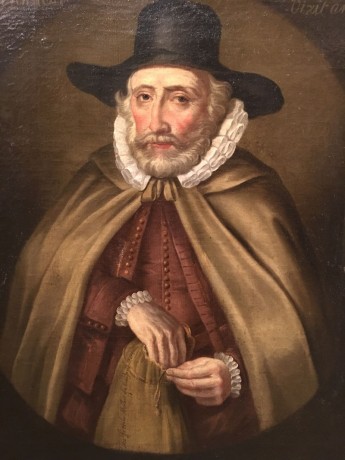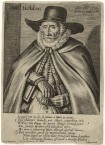English School, mid-18th century, after John Payne (c. 1607-1648).
Portrait of Thomas Hobson (1544-1631), half-length, the bearded elderly man in a broad-brimmed black hat, large ruff and cloak, holding a purse, within a feigned oval frame with identifying inscription ‘Mr. Hobson’ (upper left) and ‘obijt ano 1620 / Vixit annos / 86’ (upper right) and, on the purse ‘The fertile Mother of a Thousand More’, which is part of a well-known verse about Hobson. In an English mid-eighteenth century carved gilt-wood frame.
Oil on canvas, 30" x 24⅝" (76cm x 62.5cm).
Provenance :- Linley Hall, Shropshire.
Literature :- A. Oswald, ‘Linley Hall, Shropshire - II, The Home of Mr. and Mrs. Jasper More’, Country Life, 14th September 1961, p. 559, illustrated in the Dining Room.
Thomas Hobson has given his name to the expression ‘Hobson’s Choice’, meaning of course ‘no choice’. He was a carrier, based in Cambridge, and ran a mail service and livery stable transporting goods and passengers. He is said to have insisted his customers take the first horse offered them or none, hence the expression. His business evidently thrived, as the full verse from which the inscription on his purse in this painting is taken, runs as follows :-
‘Witness the Bagg he wears, though seeming poore,
The fertile Mother of a hundred more
He was a thriving man, through lawfull Gaine
And wealthy grew by warrantable paine’.
Hobson's Conduit in Cambridge, built in the early-17th century to bring fresh water into the city and funded by Thomas Hobson, is a lasting memorial to him. The Museum of Cambridge has a portrait of Hobson that was given to the museum in 1939 by John Maynard Keynes.
The National Portrait Gallery has another, similar, portrait of Hobson, by an unknown artist and dated 1629 (see Roy Strong, Tudor and Jacobean Portraits, 1969, p. 167; and David Saywell and Jacob Simon, Complete Illustrated Catalogue, National Portrait Gallery London, 2004, p. 305). It also has four prints of Thomas Hobson, which are the same image as this present portrait, with the same inscription. Two are by John Payne, and mid-17th century, two after Payne and dated late-18th or early 19th century. This present portrait is presumably mid-18th century, in its original frame, after Payne. Curiously, the artist has made a mistake in the date at the top right, which is clearly 1620 in this portrait, but clearly 1630 in the Payne portrait.


